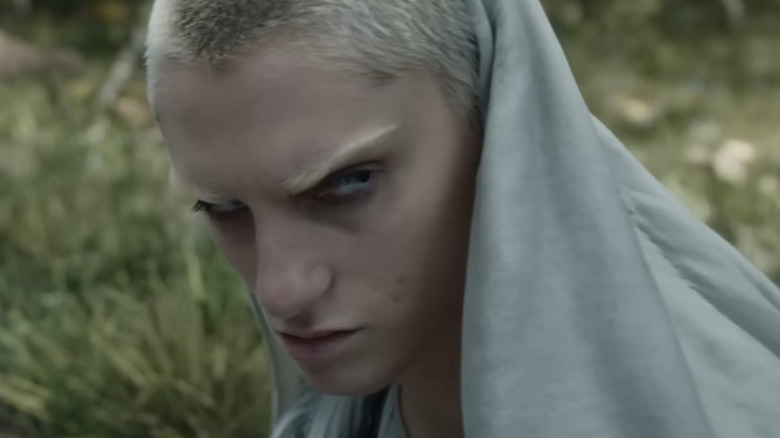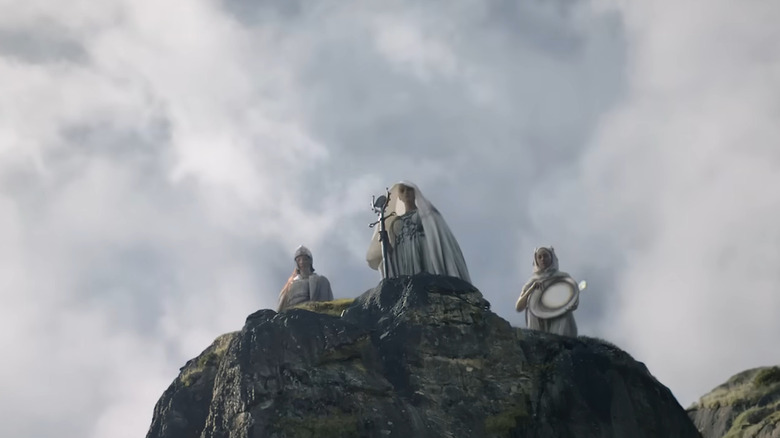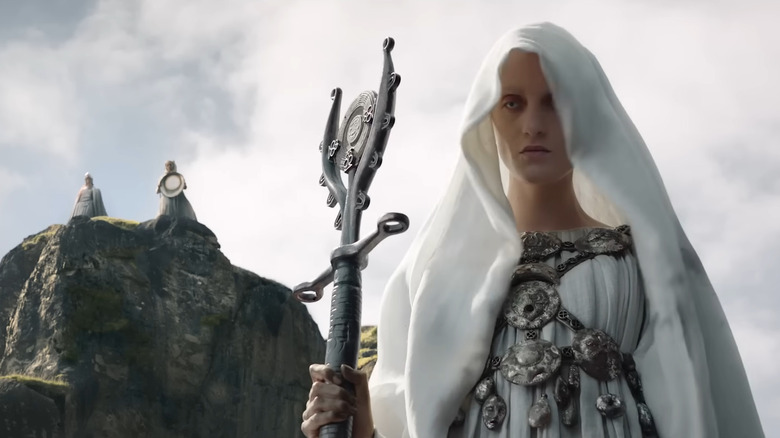What True Tolkien Experts Know About The Mystics On Amazon's The Rings Of Power
Middle-earth magic is generally a quiet, subtle affair. Occasionally you'll get something bigger, like a Wizard duel in Peter Jackson's films (although there's nothing that dramatic in the books). Often the biggest signs of magic are things like Gandalf lighting a fire with his staff or a Palantir letting you see something far away. So, when a group of menacing mystics shows up from out of nowhere in Season 1, Episode 5 of "The Rings of Power" and look like they're channeling or sensing something in the earth, it begs the question, "who are these guys?"
If you're wondering why we're calling them mystics, it's because of the song from the show's soundtrack that starts playing when the white-clad fellows arrive. The song is called "The Mystics," which clears up their title, but it doesn't say much about their identity. Who are these creepy-looking characters who show up out of nowhere investigating the Stranger's crater? They have singed hands and symbolic accouterments, and they've shown up a couple of times in the promotional footage. While it's hard to give a specific answer until we see more of "The Rings of Power" story, there are a few areas in the source material that can provide at least a partial answer to the mystic mystery.
Organized religion tends to get a bad rap in Middle-earth
J.R.R. Tolkien was a devoutly religious man, and that is reflected in things like Middle-earth's Creator, Ilúvatar, and the sense of destiny woven throughout his stories. However, the author rarely inserted actual, organized religion into his world, and when he did, it tended to appear in a negative light. While they have their own flaws, the Elves rarely fall into this category. Instead, it's gullible Men who are the most often tricked into evil acts of worship. This appears to be a rampant issue in the eastern regions of the continent, where Sauron spends a lot of his time dominating the locals and promoting the worship of his previous master, Morgoth.
In fact, the book "The Peoples of Middle-earth" explains the task of the two Blue Wizards, who are sent along with Gandalf, Saruman, and Radagast to resist Sauron, saying that "Their task was to circumvent Sauron: to bring help to the few tribes of Men that had rebelled from Melkor-worship—" In another letter, Tolkien flips the script, speculating on the fate of the two mysterious Wizards and pointing out that they went into the east of Middle-earth, where they likely failed in their mission, adding that "I fear that they failed, as Saruman did, though doubtless in different ways; and I suspect they were founders or beginners of secret cults and 'magic' traditions that outlasted the fall of Sauron."
It would appear that the mystics we're seeing in "The Rings of Power" could be some of the Melkor-worshippers and cultists that exist in untold numbers throughout Middle-earth history away to the east (not far off from the place where the Stranger initially falls). But cultish worship isn't exclusive to that region.
Evil worship in the West
While J.R.R. Tolkien reserved the really bad religious behavior for Men rather than Elves, he talks about times when it spread even to the Men who were the closest to that immortal race. For instance, in yet another letter he wrote in 1964, Tolkien summarized the sequel that he started writing for "The Lord of the Rings." In the missive, he discusses the discontented nature of the Men of Gondor and mentions several revolutionary plots centered on some form of Satanism. Of course, that story never got off the ground — but there's another one that did. (And we're in serious spoiler territory here.)
"The Silmarillion" paints a vivid picture of how horrifying Melkor-worship can be when it talks about the religion finally reaching the shores of Númenor itself. The text says that many of the Númenóreans, led by Sauron, embrace the worship of Melkor, and that "in that temple, with spilling of blood and torment and great wickedness, men made sacrifice to Melkor that he should release them from Death." In a note to his publisher in 1951, Tolkien also talks about how, "The Númenóreans carry their evil also to Middle-earth and there become cruel and wicked lords of necromancy, slaying and tormenting men; and the old legends are overlaid with dark tales of horror." Even then, though, he points out that this doesn't happen in the areas near the Elves.
While the mystics in Episode 5 are likely from already established cults in the east of Middle-earth, it may only be a matter of time before they make their creeping way across the continent and over the water to the shores of the previously blessed Númenórean homeland itself.


